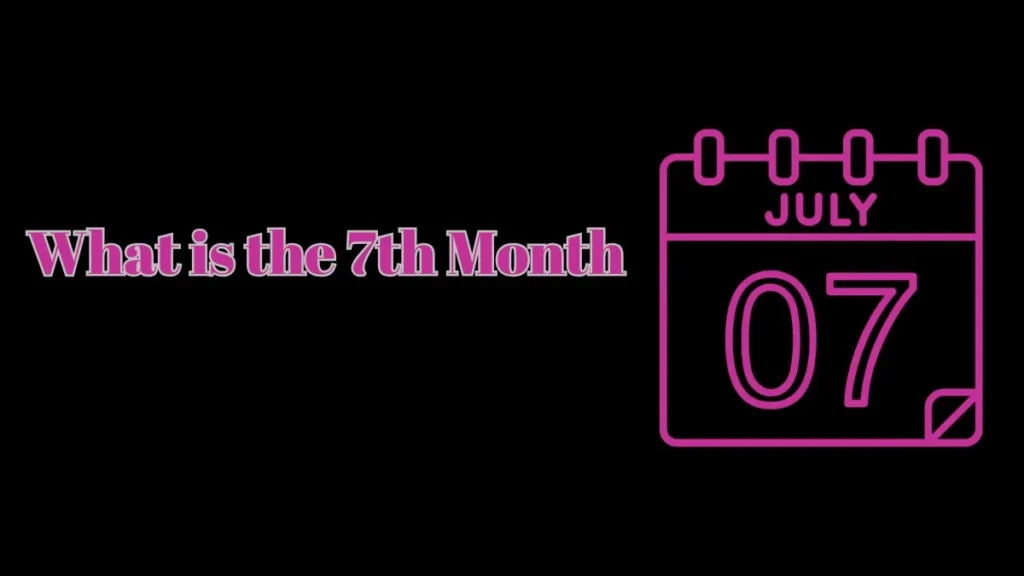The question, “What is the 7th month?” may seem simple at first glance, but its answer varies depending on the calendar system being referenced. In this article, we will delve deep into the seventh month as understood in the Gregorian calendar, Islamic lunar calendar, and other prominent timekeeping systems. We will also explore their historical, cultural, and religious significance, providing a comprehensive look at how the concept of the seventh month has evolved over time.
The 7th Month in the Gregorian Calendar: July
The Gregorian calendar, the most widely used civil calendar worldwide, designates July as the seventh month. With 31 days, July marks the height of summer in the Northern Hemisphere and winter in the Southern Hemisphere.
Historical Background
The name “July” honors Julius Caesar, the Roman general and statesman pivotal in transforming the Roman Republic into the Roman Empire. Originally, the month was called Quintilis, meaning “fifth” in Latin, as it was the fifth month in the early Roman calendar. However, with the calendar reform by Julius Caesar in 46 BCE—creating what we now know as the Julian calendar—January and February were added, making Quintilis the seventh month. In 44 BCE, the Roman Senate renamed Quintilis to July in honor of Caesar’s birth month.
Significance of July
July holds a special place in various cultures and regions, including:
- United States: Celebrates Independence Day on July 4th, marking the country’s declaration of independence in 1776.
- France: Observes Bastille Day on July 14th, commemorating the French Revolution.
- Japan: Hosts the Gion Matsuri, one of the most famous traditional festivals.
- India: Experiences the monsoon season, making July significant for agriculture and water resources.
The 7th Month in the Islamic Lunar Calendar: Rajab
In the Islamic calendar, the seventh month is Rajab, a sacred period observed by Muslims worldwide. Unlike the Gregorian calendar, which is solar-based, the Islamic calendar follows lunar cycles, resulting in shorter years and a shifting position of months relative to the Gregorian calendar.
Etymology and Historical Roots
The name “Rajab” derives from an Arabic root meaning “to respect.” It is one of the four sacred months mentioned in the Quran (Surah At-Tawbah 9:36), during which acts of violence, including warfare, are traditionally prohibited.
Religious and Cultural Importance
Rajab is significant in Islam for several reasons:
- Sacred Status: Rajab is considered a time of heightened spirituality and reflection. Many Muslims use this month to increase their prayers, fasting, and acts of charity in preparation for Ramadan, which follows two months later.
- Isra and Mi’raj: The miraculous night journey and ascension of the Prophet Muhammad, known as Isra and Mi’raj, is believed to have occurred during Rajab. This event holds deep spiritual significance, highlighting the Prophet’s journey to the heavens and his closeness to Allah.
- Traditional Practices:
- Increased fasting: Some Muslims fast during the first few days of Rajab, following the Sunnah (traditions) of the Prophet Muhammad.
- Supplications: Special prayers and supplications are made, seeking forgiveness and blessings.
Comparison of July and Rajab
To better understand the differences and similarities between the seventh months in the Gregorian and Islamic calendars, let’s examine their characteristics side by side:
| Aspect | July (Gregorian Calendar) | Rajab (Islamic Lunar Calendar) |
| Calendar System | Gregorian (solar-based) | Islamic (lunar-based) |
| Length | 31 days | 29 or 30 days (depending on lunar sighting) |
| Season | Summer in Northern Hemisphere; winter in Southern Hemisphere | Variable, as the lunar calendar shifts annually |
| Etymology | Named after Julius Caesar | Derived from Arabic root meaning “to respect” |
| Religious Significance | Secular celebrations such as Independence Day and Bastille Day | Sacred month in Islam; significant for Isra and Mi’raj |
| Cultural Practices | Fireworks, festivals, and national holidays | Increased worship, fasting, and reflection |
Other Calendars and Their 7th Months
Beyond the Gregorian and Islamic calendars, other calendar systems also have unique seventh months with distinct meanings and traditions.
Hebrew Calendar: Tammuz
In the Hebrew calendar, the seventh month is Tammuz, which usually falls in June or July. It is a month of mourning and fasting, commemorating the breaching of Jerusalem’s walls before the destruction of the Second Temple in 70 CE.
Chinese Lunar Calendar
In the traditional Chinese lunar calendar, the seventh month is often associated with the Ghost Festival. This month is believed to be a time when spirits and ancestors visit the living world. Families perform rituals to honor their ancestors and ward off malevolent spirits.
Hindu Calendar: Ashadha
In the Hindu lunisolar calendar, the seventh month is Ashadha. This period often marks the monsoon season and includes significant festivals such as Rath Yatra, the chariot festival of Lord Jagannath.
The Evolution of Timekeeping
Understanding “what is the 7th month” requires a brief exploration of how humanity has developed timekeeping systems. Early calendars were heavily influenced by agricultural needs, religious practices, and celestial observations. Over time, societies refined their calendars to better align with the solar year, lunar cycles, or both.
The Roman Calendar
The Roman calendar originally consisted of ten months, beginning with March and ending in December. It wasn’t until the inclusion of January and February, under King Numa Pompilius, that the calendar evolved into a 12-month system.
Lunar vs. Solar Calendars
- Solar calendars, like the Gregorian calendar, are aligned with the Earth’s orbit around the Sun, ensuring consistency with the seasons.
- Lunar calendars, such as the Islamic calendar, follow the moon’s phases, resulting in shorter years and months that shift relative to the solar year.
Hybrid Calendars
Some calendars, like the Hebrew and Hindu systems, are lunisolar, combining lunar months with occasional adjustments to align with the solar year.
The Cultural Relevance of the 7th Month Today
In today’s globalized world, the seventh month holds diverse meanings across cultures. Whether it’s the summer vacations and national celebrations of July or the sacred practices observed during Rajab. These months continue to shape our collective experiences and traditions.
Festivals and Events
From Independence Day in the United States to the Ghost Festival in China. The seventh month is a time for both solemn reflection and joyful celebration. These events reflect humanity’s shared desire to honor history, faith, and community.
Modern Implications
As technology advances, our reliance on precise timekeeping systems grows. Yet, the cultural and historical significance of traditional calendars remains a vital link to our past. Reminding us of the rich tapestry of human civilization.
Conclusion
The answer to “what is the 7th month” varies depending on the context and calendar in question. In the widely used Gregorian calendar, it is July, a month rich in historical and cultural significance. In the Islamic lunar calendar, it is Rajab, a sacred month that fosters spiritual growth and reflection. Other calendars, such as the Hebrew, Chinese, and Hindu systems, also offer unique perspectives on the seventh month, highlighting the diversity of human traditions.
Understanding these differences enriches our appreciation of global cultures and the ways in which societies mark the passage of time. Whether through celebrations, worship, or historical commemoration. The seventh month remains a significant period that continues to shape human life across the world.







